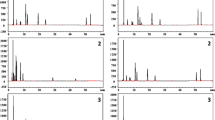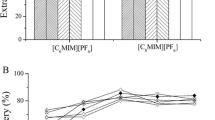Abstract
A simple and green sample preparation protocol using dispersive pipette extraction (DPX) followed by identification and quantification by high-performance liquid chromatography (HPLC) is proposed for the determination of 11 polyphenols, including phenolic acids and flavonoids, in grape juice. Sample preparation variables by DPX, including extraction phase, sample volume, pH, desorption solvent, salt concentration, time and cycles of extraction and desorption, were evaluated and optimized using univariate and multivariate designs. The analytical performance was satisfactory, with coefficient of determination greater than or equal to 0.9621, precisions with values lower than 20%, and recoveries ranging from 80 to 120%, demonstrating good method trueness. In addition, the method proved to be robust and showed no matrix effect. Finally, the method was applied to determine polyphenols in three grape juice samples. The major compounds determined in the samples were chlorogenic acid (70.84–120.70 mg L−1) and gallic acid (69.62–96.08 mg L−1). Finally, the green character of this method was evaluated using the tools Green Analytical Procedure Index (GAPI), Analytical Greenness Metric (AGREE), and Analytical Greenness Metric for Sample Preparation (AGREEprep). According to the metrics, an excellent green character was determined, emphasizing the minimization of sample (160 μL) and solvent (200 μL) volumes, as well as the short extraction time (< 5 min).
Graphical Abstract






Similar content being viewed by others

Data Availability
The datasets generated during and/or analyzed during the current study are available from the corresponding author on reasonable request.
References
Aguiar CAS Jr, dos Santos ALR, de Faria AM (2020) Disposable pipette extraction using a selective sorbent for carbendazim residues in orange juice. Food Chem 309:125756. https://doi.org/10.1016/j.foodchem.2019.125756
AOAC (2016) Appendix F: guidelines for standard method performance requirements. In: AOAC official methods of analysis
Aresta A, Cotugno P, Massari F, Zambonin C (2018) Determination of trans-resveratrol in wines, spirits , and grape juices using solid-phase micro extraction coupled to liquid chromatography with UV diode-array detection. Food Anal Methods 426–431. https://doi.org/10.1007/s12161-017-1013-0
Bai J, Zhang Y, Tang C, Hou Y, Ai X, Chen X, Zhang Y, Wang X, Meng X (2021) Gallic acid: pharmacological activities and molecular mechanisms involved in inflammation-related diseases. Biomed Pharmacother 133. https://doi.org/10.1016/j.biopha.2020.110985
Behera PK, Devi S, Mittal N (2023) Therapeutic potential of gallic acid in obesity: considerable shift! Obesity Medicine 37:100473. https://doi.org/10.1016/j.obmed.2022.100473
Bordin D, Alves M, De Campos E, Martinis B (2016) Disposable pipette tips extraction: fundamentals, applications and state of the art. J Sep Sci 39(6):1168–1172. https://doi.org/10.1002/jssc.201500932
Cai L, Koziel JA, Dharmadhikari M, van Leeuwen J (2009) Rapid determination of trans-resveratrol in red wine by solid-phase microextraction with on-fiber derivatization and multidimensional gas chromatography-mass spectrometry. J Chromatogr A 1216(2):281–287. https://doi.org/10.1016/j.chroma.2008.11.050
Carasek E, Morés L, Huelsmann RD (2022) Disposable pipette extraction: a critical review of concepts, applications, and directions. Anal Chim Acta 1192. https://doi.org/10.1016/j.aca.2021.339383
da Conceição Prudêncio Dutra M, da Silva ABM, de Souza Ferreira E, de Brito Araujo Carvalho AJ, dos Santos Lima M, Biasoto ACT (2023) Bioaccessibility of phenolic compounds from Brazilian grape juices using a digestion model with intestinal barrier passage. Food Biosci 52. https://doi.org/10.1016/j.fbio.2023.102501
da Silva Haas IC, Toaldo IM, de Gois JS, Borges DLG, de Oliveira Petkowicz CL, Bordignon-Luiz MT (2016) Phytochemicals, monosaccharides and elemental composition of the non-pomace constituent of organic and conventional grape juices (Vitis labrusca L.): effect of drying on the bioactive content. Plant Foods Hum Nutr 71(4):422–428. https://doi.org/10.1007/s11130-016-0579-9
da Silva Padilha CV, Miskinis GA, de Souza MEAO, Pereira GE, de Oliveira D, Bordignon-Luiz MT, dos Santos Lima M (2017) Rapid determination of flavonoids and phenolic acids in grape juices and wines by RP-HPLC/DAD: method validation and characterization of commercial products of the new Brazilian varieties of grape. Food Chem 228:106–115. https://doi.org/10.1016/j.foodchem.2017.01.137
Dong M (2019) HPLC/UHPLC maintenance and troubleshooting. In: HPLC and UHPLC for Practicing Scientists, 2nd edn. https://doi.org/10.1002/9781119313786.ch8
dos Santos Lima M, da Conceição Prudêncio Dutra M, Toaldo IM, Corrêa LC, Pereira GE, de Oliveira D, Bordignon-Luiz MT, Ninow JL (2015) Phenolic compounds, organic acids and antioxidant activity of grape juices produced in industrial scale by different processes of maceration. Food Chem 188:384–392. https://doi.org/10.1016/j.foodchem.2015.04.014
Gałuszka A, Migaszewski Z, Namieśnik J (2013) The 12 principles of green analytical chemistry and the SIGNIFICANCE mnemonic of green analytical practices. TrAC - Trends in Analytical Chemistry 50:78–84. https://doi.org/10.1016/j.trac.2013.04.010
Giusti F, Caprioli G, Ricciutelli M, Vittori S, Sagratini G (2017) Determination of fourteen polyphenols in pulses by high performance liquid chromatography-diode array detection (HPLC-DAD) and correlation study with antioxidant activity and colour. Food Chem 221:689–697. https://doi.org/10.1016/j.foodchem.2016.11.118
Granato D, de Magalhães Carrapeiro M, Fogliano V, van Ruth SM (2016) Effects of geographical origin, varietal and farming system on the chemical composition and functional properties of purple grape juices: a review. Trends Food Sci Technol 52:31–48. https://doi.org/10.1016/j.tifs.2016.03.013
Guler A (2023) Effects of different maceration techniques on the colour, polyphenols and antioxidant capacity of grape juice. Food Chem 404(PA):134603. https://doi.org/10.1016/j.foodchem.2022.134603
Karageorgou E, Samanidou V (2014) Youden test application in robustness assays during method validation. J Chromatogr A 1353:131–139. https://doi.org/10.1016/j.chroma.2014.01.050
Kersh DME, Hammad G, Donia MS, Farag MA (2023) A comprehensive review on grape juice beverage in context to its processing and composition with future perspectives to maximize its value. Food Bioproc Tech 16(1):1–23. https://doi.org/10.1007/s11947-022-02858-5
Leonardi F, Veschetti M, Tonnarini S, Cardellini F, Trevisi R (2015) A step towards accreditation: a robustness test of etching process. Appl Radiat Isot 102:93–97. https://doi.org/10.1016/j.apradiso.2015.05.002
Lucci P, Saurina J, Núñez O (2017) Trends in LC-MS and LC-HRMS analysis and characterization of polyphenols in food. TrAC Trends Anal Chem 88:1–24. https://doi.org/10.1016/j.trac.2016.12.006
Mesquita LM, Contieri LS, Sanches VL, Kamikawachi R, Sosa FHB, Vilegas W, Rostagno MA (2023) Fast and green universal method to analyze and quantify anthocyanins in natural products by UPLC-PDA. Food Chem 428(July):136814. https://doi.org/10.1016/j.foodchem.2023.136814
Morés L, Ramos G, Ossamu R, Kitamura S, Eller S, Franco T, Carasek E, Merib J (2021) Assessment of a natural extraction phase in disposable pipette extraction coupled with the sub-minute determination of 11-nor- Δ 9 -tetrahydrocannabinol-9-carboxylic acid in human urine by. Sustain Cheistry and Pharmacy 20:100390. https://doi.org/10.1016/j.scp.2021.100390
Obafemi TO, Ekundayo BE, Adewale OB, Obafemi BA, Anadozie SO, Adu IA, Onasanya AO, Ekundayo SK (2023) Gallic acid and neurodegenerative diseases. Phytomedicine Plus 3(4):100492. https://doi.org/10.1016/j.phyplu.2023.100492
Padilha C, dos Santos Lima M, Maia Toaldo I, Elias Pereira G, Terezinha Bordignon-Luiz M (2019) Effects of successive harvesting in the same year on quality and bioactive compounds of grapes and juices in semi-arid tropical viticulture. Food Chem 301:125170. https://doi.org/10.1016/j.foodchem.2019.125170
Pena-Pereira F, Wojnowski W, Tobiszewski M (2020) AGREE - Analytical GREEnness metric approach and software. Anal Chem 92(14):10076–10082. https://doi.org/10.1021/acs.analchem.0c01887
Pereira-Coelho M, Haas I, Dognini J, Amboni R, Vitali L, Madureira L (2023) A green analytical method for the determination of polyphenols in wine by dispersive pipette extraction and LC-MS/MS. Food Chem 405. https://doi.org/10.1016/j.foodchem.2022.134860
Płotka-Wasylka J (2018) A new tool for the evaluation of the analytical procedure: Green Analytical Procedure Index. Talanta 181:204–209. https://doi.org/10.1016/j.talanta.2018.01.013
Rashmi HB, Negi PS (2020) Phenolic acids from vegetables: a review on processing stability and health benefits. Food Res Int 136:109298. https://doi.org/10.1016/j.foodres.2020.109298
Robles A, Fabjanowicz M, Plotka-Wasylka J, Konieczka P (2019) Organic acids and polyphenols determination in polish wines by ultrasound-assisted solvent. Molecules 24:1–20
Sabra A, Netticadan T, Wijekoon C (2021) Grape bioactive molecules, and the potential health benefits in reducing the risk of heart diseases. Food Chemistry: X 12:100149. https://doi.org/10.1016/j.fochx.2021.100149
Sajid M, Płotka-Wasylka J (2018) Combined extraction and microextraction techniques: recent trends and future perspectives. TrAC - Trends in Analytical Chemistry 103:74–86. https://doi.org/10.1016/j.trac.2018.03.013
Seraglio SKT, Valese AC, Daguer H, Bergamo G, Azevedo MS, Gonzaga LV, Fett R, Costa ACO (2016) Development and validation of a LC-ESI-MS/MS method for the determination of phenolic compounds in honeydew honeys with the diluted-and-shoot approach. Food Res Int 87:60–67. https://doi.org/10.1016/j.foodres.2016.06.019
Singh SK, Thakur K, Sharma V, Saini M, Sharma D, Vishwas S, Kakoty V, Pal RS, Chaitanya MVNL, Babu MR, Gupta S, ur Rehman Z, Singla M, Gupta G, Jakhmola V, de Jesus Andreoli Pinto T, Kumbhar P, Disouza J, Patravale V et al (2023) Exploring the multifaceted potential of chlorogenic acid: Journey from nutraceutical to nanomedicine. South African J Botany 159:658–677. https://doi.org/10.1016/j.sajb.2023.06.038
Tashakkori P, Tağaç AA, Merdivan M (2021) Fabrication of montmorillonite/ionic liquid composite coated solid-phase microextraction fibers for determination of phenolic compounds in fruit juices by gas chromatography and liquid chromatography. J Chromatogr A 1635. https://doi.org/10.1016/j.chroma.2020.461741
Toaldo IM, Cruz FA, Alves TDL, De Gois JS, Borges DLG, Cunha HP, Da Silva EL, Bordignon-Luiz MT (2015) Bioactive potential of Vitis labrusca L. grape juices from the Southern Region of Brazil: phenolic and elemental composition and effect on lipid peroxidation in healthy subjects. Food Chem 173:527–535. https://doi.org/10.1016/j.foodchem.2014.09.171
Tousch D, Lajoix AD, Hosy E, Azay-Milhau J, Ferrare K, Jahannault C, Cros G, Petit P (2008) Chicoric acid, a new compound able to enhance insulin release and glucose uptake. Biochem Biophys Res Commun 377(1):131–135. https://doi.org/10.1016/j.bbrc.2008.09.088
Turazzi FC, Morés L, Carasek E, Merib J, De Oliveira Barra GM (2019) A rapid and environmentally friendly analytical method based on conductive polymer as extraction phase for disposable pipette extraction for the determination of hormones and polycyclic aromatic hydrocarbons in river water samples using high-performance l. J Environ Chem Eng 7(3):103156. https://doi.org/10.1016/j.jece.2019.103156
Wojnowski W, Tobiszewski M, Pena-Pereira F, Psillakis E (2022) AGREEprep – analytical greenness metric for sample preparation. TrAC Trends Anal Chem 149:116553. https://doi.org/10.1016/j.trac.2022.116553
Yang P, Li H, Wang H, Han F, Jing S, Yuan C, Guo A, Zhang Y, Xu Z (2017) Dispersive liquid-liquid microextraction method for HPLC determination of phenolic compounds in wine. Food Anal Methods 10(7):2383–2397. https://doi.org/10.1007/s12161-016-0781-2
Funding
The authors are grateful to the Brazilian governmental agencies Conselho Nacional de Desenvolvimento Científico e Tecnológico (CNPq) and Coordenação de Aperfeiçoamento de Pessoal de Nível Superior (CAPES) (Finance Code 001) for the financial support that made this research possible.
Author information
Authors and Affiliations
Contributions
M.P.: Conceptualization, Methodology, Writing – original draft. I.C.H.: Methodology, Writing – review & editing. L.V.: Writing – review & editing, Supervision. L.A.M.: Writing – review & editing, Supervision. All authors reviewed the manuscript.
Corresponding author
Ethics declarations
Conflict of Interest
Marina Pereira-Coelho declares that she has no conflict of interest. Isabel Cristina da Silva Haas declares that she has no conflict of interest. Luciano Vitali declares that he has no conflict of interest. Luiz Augusto dos Santos Madureira declares that he has no conflict of interest.
Competing Interests
The authors declare no competing interests.
Additional information
Publisher’s Note
Springer Nature remains neutral with regard to jurisdictional claims in published maps and institutional affiliations.
Supplementary Information
ESM 1
(DOCX 330 kb)
Rights and permissions
Springer Nature or its licensor (e.g. a society or other partner) holds exclusive rights to this article under a publishing agreement with the author(s) or other rightsholder(s); author self-archiving of the accepted manuscript version of this article is solely governed by the terms of such publishing agreement and applicable law.
About this article
Cite this article
Pereira-Coelho, M., da Silva Haas, I.C., Vitali, L. et al. Dispersive Pipette Extraction and HPLC-DAD for the Determination of Polyphenols in Grape Juice. Food Anal. Methods 17, 269–283 (2024). https://doi.org/10.1007/s12161-023-02565-7
Received:
Accepted:
Published:
Issue Date:
DOI: https://doi.org/10.1007/s12161-023-02565-7



